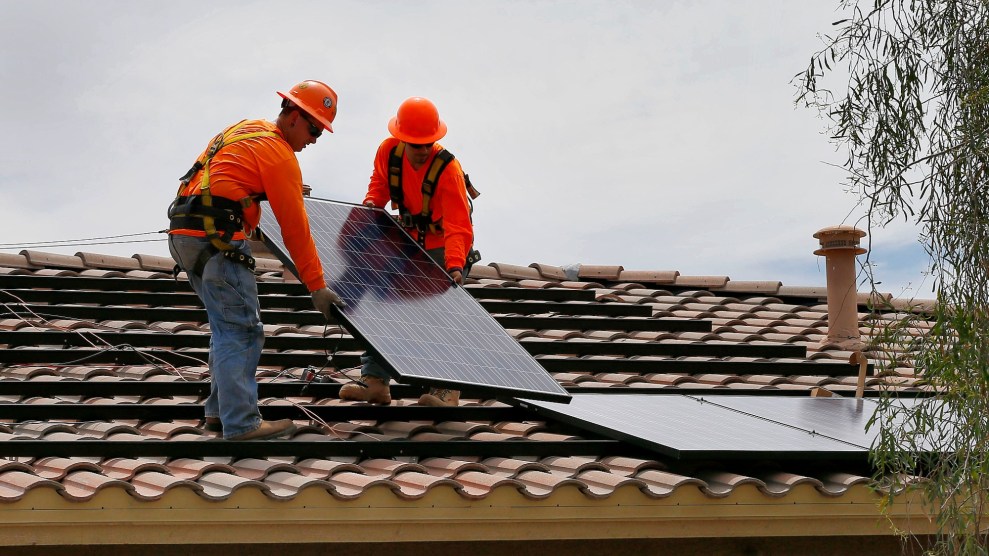
Especially if you live in a city, it’s worth getting professional testing—home testing kits have been found to return up to 50 percent false negatives. If significant levels are found, here’s where they might come from.
![]() 1. Water Water pipes and solder in older homes often contain lead; even new fixtures can be up to 8 percent lead. (A federal law lowering the limit to 0.25 percent takes effect in 2014.) The oft-recommended fix of running the tap for several minutes is wasteful and not always effective; better to install a NSF-approved filter at the tap.
1. Water Water pipes and solder in older homes often contain lead; even new fixtures can be up to 8 percent lead. (A federal law lowering the limit to 0.25 percent takes effect in 2014.) The oft-recommended fix of running the tap for several minutes is wasteful and not always effective; better to install a NSF-approved filter at the tap.
![]() 2. Countertops and Floors Dust from paint and soil can accumulate on surfaces. Wipe them down even more often than usual if you have kids of everything-goes-into-the-mouth age.
2. Countertops and Floors Dust from paint and soil can accumulate on surfaces. Wipe them down even more often than usual if you have kids of everything-goes-into-the-mouth age.
![]() 3. Windows Friction from opening and closing old windows wears down paint and creates lead dust. The safest bet is replacing them. The EPA certifies lead-safe contractors, and some states offer subsidies.
3. Windows Friction from opening and closing old windows wears down paint and creates lead dust. The safest bet is replacing them. The EPA certifies lead-safe contractors, and some states offer subsidies.
![]() 4. Paint Sanding, scraping, and even chemically stripping old paint releases lead; it’s better to seal the stuff in with a fresh coat. If you must scrape, wet the paint to keep down dust, or bring in abatement professionals.
4. Paint Sanding, scraping, and even chemically stripping old paint releases lead; it’s better to seal the stuff in with a fresh coat. If you must scrape, wet the paint to keep down dust, or bring in abatement professionals.
![]() 5. Soil The most thorough fix is a “dig and haul,” in which six inches of contaminated soil is trucked out and replaced with clean dirt. Covering the soil with a carpetlike geotextile and layering clean dirt on top costs a lot less; short of that, mulch or plant grass over contaminated soil to keep lead particles from being blown back into the air.
5. Soil The most thorough fix is a “dig and haul,” in which six inches of contaminated soil is trucked out and replaced with clean dirt. Covering the soil with a carpetlike geotextile and layering clean dirt on top costs a lot less; short of that, mulch or plant grass over contaminated soil to keep lead particles from being blown back into the air.
![]() 6. Urban Farming If your soil is lead contaminated (some ag extension programs do free or low-cost tests), be careful what you grow. Eggs from New York City chickens were found to have lead levels up to twice the feds’ daily limit for kids under six. Among vegetables, roots like carrots take up the most lead, fruits like tomatoes and squash the least. (Tree fruits are pretty much safe.) One fix: Grow lead-absorbing plants like spinach and mustard, then throw them out; this may lower soil lead levels as much as 200 ppm in three months.
6. Urban Farming If your soil is lead contaminated (some ag extension programs do free or low-cost tests), be careful what you grow. Eggs from New York City chickens were found to have lead levels up to twice the feds’ daily limit for kids under six. Among vegetables, roots like carrots take up the most lead, fruits like tomatoes and squash the least. (Tree fruits are pretty much safe.) One fix: Grow lead-absorbing plants like spinach and mustard, then throw them out; this may lower soil lead levels as much as 200 ppm in three months.
 7. Airplane Fuel About 75 percent of private planes still fly with leaded aviation gas; a 2011 study found that children living closer to airports had higher levels of lead in their blood. There are lead-free alternatives, but the industry has been slow to adopt them, and regulators haven’t pushed.
7. Airplane Fuel About 75 percent of private planes still fly with leaded aviation gas; a 2011 study found that children living closer to airports had higher levels of lead in their blood. There are lead-free alternatives, but the industry has been slow to adopt them, and regulators haven’t pushed.








